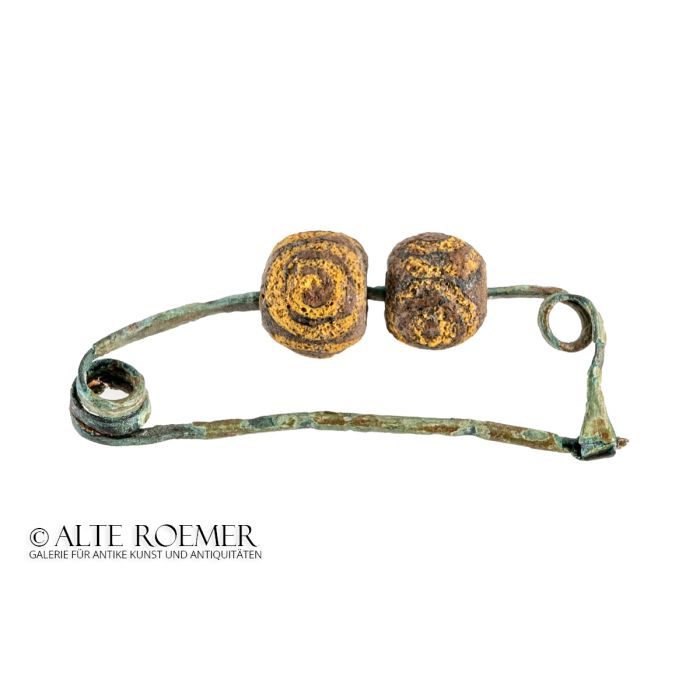Early Italic brooch decorated with beads
Price: on request
Sold
Object number
AR3161F
| Object: |
Early Italic fibula from the Hattatt collection
|
| Material: |
Fibula made of Bronze. Beads made of yellow and brown glass paste.
|
| Period: |
9th to 8th cent. BC. Early Iron Age of Italy. |
| Description: |
Rare early Italic fibula consisting of thick bronze wire decorated with two beads. The bow transitions into a double coil spring at the head and continues to form the pin. Towards the foot is a single coil followed by a long thin catch plate made from the flattened end of the wire. The beads are made of glass paste and feature a pattern of brown concentric circles on a yellow background. Hattatt remarks that this fibula probably originates in northern Italy. It is based on predecessors from Greece. The type came up there around 1200 BC with beaded variants evolving until 900 BC. |
| Background: |
The Iron Age brooches of the Mediterranean were mostly simple productions, made of a single piece of thick wire. Still, the Italic peoples developed their own distinctive styles. Fibulae come with decorations such as glass beads, bone ornaments or amber. Their sizes range from about 3cm to 30cm length. Hattatt is giving a broad overview on the Italic Iron Age fibulae in his Ancient and Romano-British Brooches (1982), pp. 186-188, figs. 79-84.
|
| Dimensions: |
4.6cm long.
|
| Condition: |
Very good condition. Body with minor restorations to one of the coils and the catch, otherwise intact. Beautiful green patina and two preserved glass beads. The "scars" on the glass surface are a typical sign of aging of the material. Collection inscription in white "1633".
|
| Provenance: |
Acquired by us on the British art market in 2021. Previously in a Dutch private collection. Acquired at Bonhams London, "Antiquities" auction of 30 November 2016, lot 44. Consigned from a European private collection. Previously in the British private collection of Richard Hattatt. Acquired between 1970 and 1982. Hattatt states Italy as passed along find spot in his "Visual Catalogue". About Richard Hattatt: After retiring from the family business, Richard Hattatt devoted himself to collecting and studying antiquities. After a few years, focusing on the area of fibulae, one of the most important collections of ancient brooches from the region north of the Mediterranean emerged. In the years 1982, 1985, 1987 and 1989, four books were the fruit of a tireless analysis and work on the specimen in his collection. Those books are now regarded as standard works in the field of Iron Age and Roman brooches. When Richard Hattatt died in 1992, parts of his collection were already housed in the Ashmolean Museum (Oxford) and the Wiltshire Museum (Devizes). Other fibulae in the collection went to auction houses and into private collections. However, the enormous gain in knowledge through the systematic collecting activity, the drawings and the information consolidated by Hattatt has been preserved for posterity in his books. It is with the appropriate pride that we can offer you this fibula from Hattatt's collection and his books. |
| Publications: |
This fibula is published in a standard work for ancient brooches, Richard Hattatt, Ancient Romano-British Brooches (1982), p. 188f, fig. 79, no. 192. Note that the numbering in the publication differs from the numbering in the collection for this piece. The fibula is also published in the reference catalogue Richard Hattatt, A Visual Catalogue of Richard Hattatt's Ancient Brooches (1989), p. 284, fig. 143, no. 192. |
| Literature: |
As an alternative to the works of Hattatt we can recommend the following book as an introduction and for referencing: R. Heynowski, Bestimmungsbuch Archäologie 1, Fibeln (2012). |
| Authenticity: |
We unconditionally guarantee the authenticity of every artefact, all items are subject to our lifetime return policy on authenticity.
|


